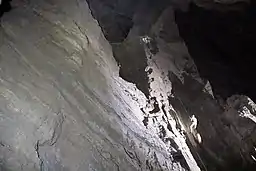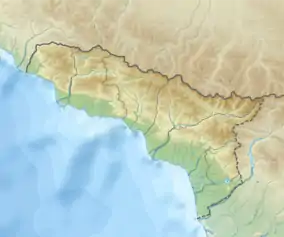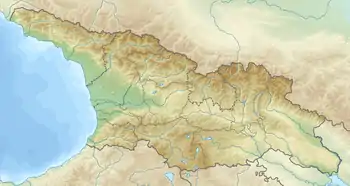Veryovkina Cave
Veryovkina Cave (also spelled Verëvkina Cave, Abkhazian: Вериовкин иҳаҧы, Russian: Пеще́ра Верёвкина, Georgian: ვერიოვკინის მღვიმე) is 2,212 meters (7,257 ft) deep and is the deepest-known cave on Earth.[1][2] Its entrance is situated 2,285 meters (7,497 ft) above sea level[3] in Abkhazia, Georgia. The entrance of the cave has a cross section of 3 m × 4 m (9.8 ft × 13.1 ft), and is located in the Arabika Massif, Gagra Mountain Range of the West Caucasus, on the pass between the Krepost[4] and Zont[5] mountains, closer to the slopes of Mt. Krepost. The depth of the entrance shaft is 32 meters (105 ft).[6]
| Veryovkina Cave | |
|---|---|
 155 m deep Babatunda pit at -400 m, the largest shaft in the cave | |
  | |
| Coordinates | 43°24′56″N 40°21′23″E |
| Depth | 2212 m |
| Length | 17500 m |
| Discovery | 1968 |
| Geology | Limestone |
Naming
In 1968, the cave was assigned the name S-115 which was later replaced by P1-7, and in 1986 it was renamed after Alexander Verëvkin. Caver and cave diver Alexander Verëvkin died in 1983 while exploring a siphon in the cave Su-Akan, located in the Sary-Tala massif, now Kabardino-Balkaria, Russia.
Discovery

.jpg.webp)
- The entrance is located in the Gagra district of Abkhazia, Georgia.
- 1968: the cave was discovered by cavers from Krasnoyarsk. They reached a depth of 115 meters (377 ft) and marked it on the map as S-115.
- 1982: the cave was discovered for the second time by the expedition of the "Perovo" speleoclub from Moscow. It was marked as P1-7.
- 1983–1986: cavers from the same team continued exploration and reached the depth of 440 m (1,440 ft).
- 1986–2000: work in the cave did not take place.
Explorations after 2000

- From 2000 to 2015 the speleoclub "Perovo" and its team "Perovo-speleo" continued research at the cave bottom. Despite all the efforts the cave depth remained at 440 m (1,440 ft).
- August 2015 – cavers from the speleoclub "Perovo" finally discovered a new shaft, but could not explore it because they did not have the rope. This discovery opened the way to a series of later discoveries.
- June 2016 – the expedition of the team "Perovo-speleo" took place. The team started from the same point. They surveyed the pit, that was some 30m deep and a small system of passages below. The next day Evgenyj Kuzmin climbed over the wall of boulders and found the head of the Babatunda pit. Its depth was later determined to be 156 m (512 ft). That expedition managed to reach a depth of 630 m (2,070 ft).
- August 2016 – a joint expedition of the "Perovo-speleo" team and the "Perovo" speleoclub reached the depth of 1,010 m (3,310 ft).
- October 2016 – the expedition of the team "Perovo-speleo" reached a depth of 1,350 m (4,430 ft).
- February 2017 – the expedition of the "Perovo-speleo" team reached the depth of 1,832 m (6,010 ft) The cave advanced to the second deepest in the world, after Krubera (Voronya) cave.
- Early August 2017 – the speleoclub "Perovo" explored the cave to the depth of 2,151 m (7,057 ft). An ancient collector of the karst aquifer system with extensive horizontal tunnels, not typical for the Arabica massif, was discovered. Veryovkina became the second super deep cave (over 2 km (1.2 mi)) and the deepest accessible without diving equipment.
- Late August 2017 – the "Perovo-speleo" team reached the depth of 2,204 m (7,231 ft), thus setting a new world depth record. A huge system of more than 6,000 m (20,000 ft) of subhorizontal passages below the −2,100 m (−6,900 ft) was discovered and surveyed.
- March 2018 – another expedition of the same team added more than a kilometer of tunnels to the cave map. They also measured the depth of The last Nemo station terminal siphon lake. It was 8.5 m (28 ft) and so the total cave depth reached 2,212 meters (7,257 ft).[1]
- September 2018 – a photo trip of "Perovo-speleo" team to the bottom of the cave took place, led by Pavel Demidov, with the English cave photographer Robbie Shone.[7] The team narrowly escaped the flood caused by a rain storm, which filled the lower level of the cave.[8][9]
- August 2019 – final cave length, 2,212 meters (7,257 ft), was surveyed by members of the speleoclub "Perovo".[10]
See also
References
- Ljubimov, Petr (12 March 2018). "Экспедиция в Верёвкина март 2018. Глубина пещеры достигла -2212 метров" [Expedition to Veryovkina in March 2018. Cave depth reached – 2212 m] (in Russian). Retrieved 25 November 2018.
- "Worlds Deepest Caves". Compiled by: Bob Gulden. October. 10, 2018
- Ljubimov, Petr. "ОТКРЫТИЕ И ИСТОРИЯ ИССЛЕДОВАНИЯ ПЕЩЕРЫ им. А. Веревкина (1968–1986 г.)" [Discovery and Exploration History of the Cave named after A. Verevkin (1968–1986)] (in Russian). Retrieved 3 April 2020.
- Kovinov, Dmitrij. "Поход по Арабике через перевалы Дзоу и Шу, 21–24 августа 2016" [Trekking through Arabica over the passes Dzou and Shu, 21–24 August 2016] (in Russian). Retrieved 8 May 2018.
- "Гора Зонт" [Zont Mountain] (in Russian). Retrieved 8 May 2018.
- "The daring journey inside the world's deepest cave". BBC Reel. Retrieved 2019-09-29.
- Walford, Shannon (16 May 2019). "Pro Team: Robbie Shone". 3 Legged Thing LTD. Retrieved 8 December 2019.
- Bisharat, Andrew; Shone, Robbie (18 October 2018). "Epic flood sends cavers scrambling for their lives / A National Geographic photographer recounts his fight to escape the world's deepest cave". National Geographic. Retrieved 18 May 2019.
- Shone, Robbie (August 2020). "The Climb of His Life". National Geographic. 238 (2): 34–36. ISSN 0027-9358. Retrieved 25 July 2020.
- Demidov, Pavel; Parfёnov, Oleg (3 April 2020). "Верёвкина" [Verëvkina]. speleoatlas.ru – Caving atlas of Russia and the Commonwealth of Independent States (CIS) (in Russian). Русское географическое общество / Russian Geographic Society. Retrieved 12 August 2020.
